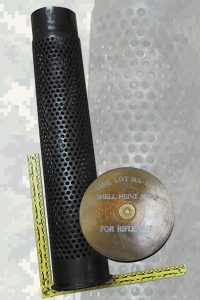Ordnance specialists investigate Cold War era military artifact
By Lookout on Aug 28, 2016 with Comments 0

Peter Mallett, Staff Writer ~
A well-intentioned Merritt, B.C. resident thought he was doing the right thing when he walked into his local RCMP detachment on July 21 to return an artillery shell he had found.
The man told front desk staff at the police station that he had discovered a 106 mm round of artillery while cleaning his parent’s house and was surrendering the item. The front desk staff were alarmed at the appearance of a very unfamiliar military weapon, said Merritt’s RCMP Detachment Staff Sergeant Sheila White.
“Let’s just say we don’t deal with situations like this very often and we didn’t know whether the shell was live or not,” said Sgt White. “From our identification of the ordnance and the fact that the primer of the shell was still intact, we were operating on the premise that it was live.”
The item was placed in a secure area and Sgt White called the RCMP’s Explosive Disposal Unit (EDU) in Vancouver.
Vancouver EDU examined the photographs that were sent to them, and observed the shell’s condition and appearance, which led them to contact the Regional Joint Operations Centre (RJOC) at CFB Esquimalt. RJOC staff relayed the information to Fleet Diving Unit (FDU) Pacific who dispatched two personnel from FDU’s Explosive Ordnance Disposal Unit (EOD).
CPO2 Rene St-Pierre and PO1 Andre Gauthier were immediately deployed to identify and safely recover the Unexploded Ordnance.
After more than seven hours driving the two sailors arrived in Merritt early on the morning of July 22, and Sgt White noted despite their lengthy journey the sailors wasted no time getting to work.
“They talked us through what they were doing and you could tell immediately they were the utmost professionals – knowledgeable, articulate, and knew what they were doing,” said Sgt White.
The pair determined the ordnance was a 106 mm HEP T round, a Cold-War era ordnance originally designed as an anti-tank weapon for the Korean War and widely used by NATO forces in the 1950s and 1960s.
They inspected the warhead and determined it posed no explosive threat because the warhead was missing from the shell’s long cylindrical casing.
“We knew the shell had been handled multiple times and was relatively safe and still in the box it was packaged in, so that quickly eased our initial concerns about this situation,” said CPO2 St-Pierre.
The item was recovered and transported back to FDU for disposal. If the ordnance had been determined unsafe for transit, they would have found a suitable near-by location for its safe disposal.
“Even if the object is proven to not pose a threat it is never a waste of time,” said CPO2 St-Pierre. “That’s because anything that is military related or ordnance of any type we would rather not take chances and recover it safely.”
Ordnance disposal is a full-time job for CPO2 St-Pierre, and he says at least five other FDU members remain on call 24 hours a day ready to respond.
Over the course of a year they respond to approximately 120 calls within their area of responsibility, which includes all DND and Government of Canada property in the Province of British Columbia; they will also respond when tasked to aid any organization or individual requiring their assistance.
Sgt White and the RCMP remind members of the public to never bring a weapon or ordnance to a police station. Instead, contact the local police detachment by phone and request an officer attend your location to recover unwanted firearms or munitions.
Filed Under: Top Stories
About the Author:





